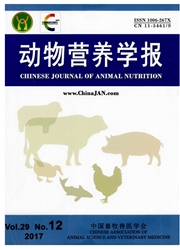

 中文摘要:
中文摘要:
猪尿氮排放量为总氮排放量的60%-70%,而尿素是尿液中的主要含氮物,其合成速率在很大程度上决定着尿氮以及总氮的排放量。因此,降低猪肝脏尿素合成速率是减少氮排放量的根本途径。本文首先介绍了当前猪氮减排常用的营养调控技术,然后分别就肝脏尿素合成的直接前体物(氨)与间接前体物(如甘氨酸和丙氨酸)以及氨基酸代谢燃料功能替代机制进行论述,在此基础上提出猪氨基酸代谢节俭机制新假说,即促进丙酮酸/葡萄糖等物质的供能效率,以降低谷氨酸等氨基酸的代谢速率,从而达到减少门静脉尿素前体物净流量、肝脏尿素合成以及尿氮排放量的目的。
 英文摘要:
英文摘要:
Urinary nitrogen excretion accounts for 60% to 70% of the total nitrogen excretion of pigs. The production rate of urea,which is the main nitrogen-containing substance in the urine,to a large extent determines the urinary nitrogen and total nitrogen excretion. Therefore,declining the production rate of urea in liver of pigs is a fundamental approach for reducing total nitrogen excretion. This reviewsummarized the existing nutrition regulatory measures for reducing nitrogen excretion in pigs,characterized the nitrogen direct precursors( ammonia) and indirect precursors( glycine and alanine) of urea synthesis in liver,and the mechanism of metabolic fuel function substitution of amino acid( AA). On this basis,a newhypothesis for the regulatory mechanism of metabolic saving of AA was proposed,the essence of which is to promote the efficiency of substances like as pyruvate / glucose being as metabolic fuel,decline metabolic rate of AA especially of glutamate,decrease the net flowof nitrogen precursors for urea synthesis in portal vein,urea synthesis in liver and urinary nitrogen excretion.
 同期刊论文项目
同期刊论文项目
 同项目期刊论文
同项目期刊论文
 期刊信息
期刊信息
